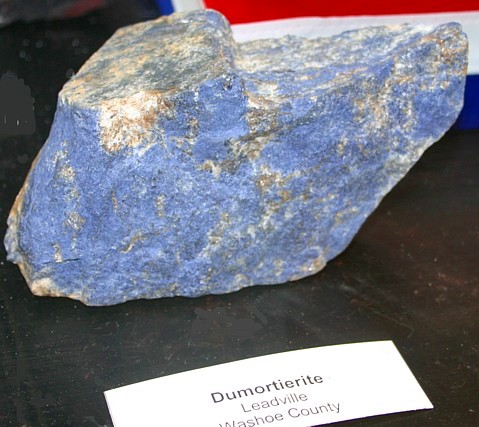|
.Dumortierite
Mineral Facts:
Chemical
Formula: Al7BO3(SiO4)3O3
Dumortierite
is a borosilicate of
aluminum with a composition approaching the formula indicated above.
Colors:
commonly
some shade of blue, can be green, lavender, white, or colorless.
Most commonly blue,
which is unusual for a silicate.
Hardness:
7
Density:
3.3
Cleavage:
One a distinct
cleavage parallel to (100).
Crystallography: Orthorhombic
Principally in fiberous
masses The mineral crystallizes in fiberous massesand aggregates of
fibers, needles or very thin prisms exhibiting only (110) and (100) without
end faces.
Luster:.
Viterous to earthy luster.
It is translucent or transparent
and strongly pleochroic, being colorless and red, purple or blue. Its
streak is light blue.
Optics:
(Refractive Index): =a=
1.678, b= 1.686, y= 1.689
|
 |
|
Composition, Structure and
Associated Minerals:
Dumortierite occurs as a constituent of gneisses, schists and pegmatites.
It typically forms in high temperature
aluminum rich rocks due to regional metamorphic forces, as well as those
resulting from contact metamorphism and also in some boron rich pegmatites.
It is evidently a pneumatolytic mineral, and its common associates are
kyanite, andalusite or sillimanite..
Identification
and Diagnostics
Before the blowpipe the
mineral loses its color and is infusible. It is insoluble in acids. It is
distinguished from other blue silicates by its fibrous or columnar character
and its insolubility in acids.
Due to its blue color,
it is sometimes
mistaken for sodalite and has been used as gem imitation lapis lazuli.
It is distinguished from these other blue materials by its fibrous or
columnar character and its insolubility in acids.
Localities
It is found in pegmatite near Lyons, France; near Schmiedeberg, in Silesia;
at Harlem, N. Y.; in a granular quartz, at Clip, Yuma Co., Ariz., and in a
dike rock composed of
quartz
and dumortierite, near Dehesa, San Diego Co., California, as a dumortierite-schist
in Pershing County, Nevada.
Industrial Uses of
Dumortierite
Used industrially in mixes to produce
high grade refractory ceramics. Occasionally it is used as a gem material
because of its attractive blue colors. Because it occurs in larger sizes, it
is used for carvings as well as cabochons.
.Return
to the
Mineral Collectors Information Page |
|


